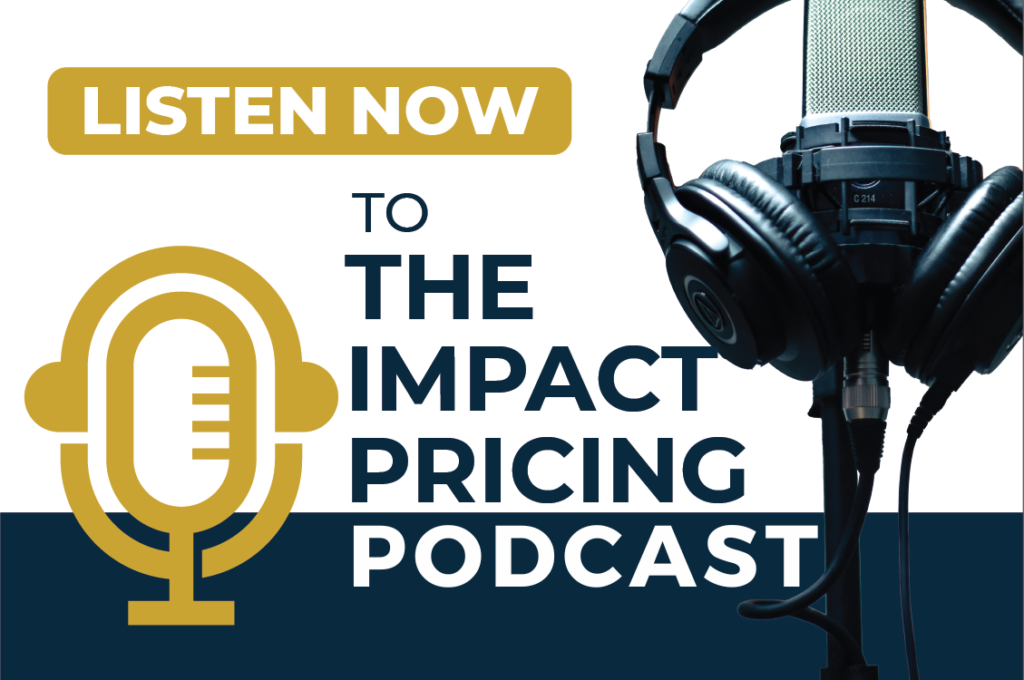Craig Wilson, Director of Pricing and Packaging at Moody’s Analytics, brings extensive experience from major financial services companies including S&P and Experian. Starting his career in financial analysis at a Scottish car retailer after his soccer dreams didn’t materialize, Craig discovered his natural strengths in numbers and analytical tools, leading him to specialize in pricing across subscription products, deal desk operations, and information technology services.
In this episode, Craig explores the dual challenge of AI in pricing: how to monetize AI-enhanced products and how to leverage AI tools for pricing decisions. Drawing from his experience at Moody’s, he discusses why traditional pricing principles still apply to AI products while acknowledging the fundamental disruption AI creates for per-user models. Craig shares practical insights on using AI as a pricing coach and the critical importance of early involvement in product development.
Podcast: Play in new window | Download
Why you have to check out today’s podcast:
- Learn why AI pricing follows traditional value-based principles but requires new approaches to pricing metrics and value capture.
- Discover practical ways to use AI tools like Microsoft Copilot for pricing strategy, stakeholder communication, and sales enablement.
- Understand the critical timing of pricing involvement in AI product development to influence monetization strategies from the ground up.
“Get involved in the product development process as early as possible, particularly in the era of Gen AI and agentic AI.”
– Craig Wilson
Topics Covered:
01:30 — Craig’s pricing journey: From Scottish car retailer to Moody’s Analytics pricing leader
04:15 — Why AI pricing fundamentals haven’t changed: Still about value creation and capture
06:30 — The consensus problem: No clear patterns yet in AI pricing
08:45 — Use case example: using AI to do pricing
11:15 — Using AI as a pricing coach: Daily conversations with Microsoft Copilot for strategy development
14:30 — Communication enhancement: Translating pricing concepts for different business personas
16:45 — Sales enablement evolution: AI-powered guidance for complex solution positioning
19:20 — Trust and validation concerns: The information vs. agentic AI distinction
21:45 — Economic value estimation: How AI can finally make this pricing holy grail practical
23:30 — The monetization investment gap: Companies building AI capabilities without pricing strategies
Key Takeaways:
“Get involved in the product development process as early as possible, particularly in the era of Gen AI and agentic AI.” – Craig Wilson
“In the world of particularly agentic AI solutions, the per-user model is becoming obsolete. I can’t see a place for it.” – Craig Wilson
Resources and People Mentioned:
- Moody’s Analytics: https://www.moodysanalytics.com/
- Tom Nagle: “Strategy and Tactics of Pricing” book: https://www.taylorfrancis.com/books/mono/10.4324/9781315266220/strategy-tactics-pricing-thomas-nagle-john-hogan-joseph-zale
- Steven Forth: https://www.linkedin.com/in/stevenforth/
- Kyle Poyar: https://www.linkedin.com/in/kyle-poyar/
- Stuart Wintertere: LinkedIn thought leader on AI value
- Microsoft Copilot: Daily AI coaching tool
Connect with Craig Wilson:
- LinkedIn: https://www.linkedin.com/in/craig-wilson-5857ba4a/
- Email: [email protected]
Connect with Mark Stiving:
- LinkedIn: https://www.linkedin.com/in/stiving/
- Email: [email protected]
Full Interview Transcript
(Note: This transcript was created with an AI transcription service. Please forgive any transcription or grammatical errors. We probably sounded better in real life.)
Craig Wilson
Get involved in the product development process as early as possible, particularly in the era of Gen AI and agentic AI.
[Intro / Ad]
Mark Stiving
Welcome to Impact Pricing, the podcast where we discuss pricing, value, and the unbreakable relationship between them. I’m Mark Stiving, and I run boot camps to help companies get paid more. Our guest today is Craig Wilson. Here are three things you want to know about Craig before we start. He is the Director of Pricing and Packaging at Moody’s.
He was a pricing monetization manager at S&P, SAP, I’m sorry. And the reason he’s here is because when I was on a webinar with Steven Forth and Michael Mansard, he made really smart comments in the chat. And I like talking to really smart people about AI. So welcome, Craig.
Craig Wilson
Thank you, Mark. I’m a big fan of the show. Pleasure to be here. You were right the first time, by the way, S&P.
Mark Stiving
S&P. Okay, got it. How’d you get into pricing?
Craig Wilson
Good question. Yeah, I’ll probably give you an answer that many of your other guests have given you, which sort of fell into it, right? So, I left school, was trying to pursue a career in sports at the time, went to university, did some sports science, tried to play a bit of football, realized that wasn’t going to happen and wasn’t going to make such a career for me.
So then I fell into the field of financial analysis for a fairly small car retailer here in Scotland. And then that quickly moved into pricing analysis. And it was at that point I got a real taste for the different dimensions that pricing touches across the different areas of the business. And actually, at that time, it started to play into two strengths, Mark.
That I was naturally quite strong at school, which was numbers and technical capabilities when it comes to things like Excel and other analytical tools. So, from there on in, it was a career that I really wanted to pursue. I got a big break at the Royal Bank of Scotland group, doing some pricing management for some of their subscription products.
And since then, I’ve really worn a couple of different hats. I’ve worked in the deal desk, selling multi-million dollar deals to these companies and the business process outsourcing world. And then more recently moved into the information technology space with Experian, S&P and now here at Moody’s.
Mark Stiving
Nice, nice. Out of curiosity, if you could move back into sports, would you do it?
Craig Wilson
I think I probably would. Yeah. I mean, listen, I was playing what you guys call soccer at the time. Right. And I’m still a massive fan of soccer. It was my dream to play soccer when I was younger. So, if I had the ability to play soccer professionally, I would absolutely grab it.
Mark Stiving
Okay, so hopefully no one at Moody’s is listening to this, but maybe you should go to some of the football teams and see if they need help with pricing.
Craig Wilson
Yeah, yeah, definitely.
Mark Stiving
Get your foot in the door that way. So, all right. The reason I invited Craig on the podcast is I wanted to talk about AI, and he’s a practitioner of pricing, and obviously he’s using AI because he was on the webinar and making really great questions.
I usually break AI up into two different topics. I think about, how do we price products that have AI? And then also how do we use AI to do pricing? And Craig agreed to talk about both of them with me. So let’s jump into the first one. Let’s do, how do you price AI products?
So I assume Moody’s is working on AI and you don’t have to tell me about what Moody’s is doing in particular, but I’m really curious, what do you see that’s different and why is AI making us think differently about pricing?
Craig Wilson
So, I actually don’t think pricing AI products differ too much from pricing 101, right? I think there are some guiding principles that we as pricing people should follow when it comes to pricing AI products. I don’t think the guiding principles for how you price AI products has significantly changed. I think what has changed in this new era is creating value for customers, right?
And how we capture that value and how we price. So the guiding principles of pricing as I see it are. Pricing strategy must align to e-business strategy or business goals, right? So do I want to capture more new business? Do I want to retain more of my customers and expand them? I think any good pricing strategy should fundamentally serve that as a business strategy.
That doesn’t change, in my view, for AI, right? I think what’s challenging about pricing AI products is twofold. One, what value am I delivering for my customer? Because this still feels very, very new.
And two, how do I capture that value in the form of a pricing metric? And it’s interesting, Mark, right? Because I’m sure you see this just as much as I do. Every day there is a study or a research paper coming out. And the consensus on this is that there isn’t much of a consensus, right? No one is doing this. There’s not a clear pattern.
So I think what we’ll probably find is maybe 12 months from today, we will start to find out who the winners and losers are when it comes to pricing AI products. And that’s when you might see a convergence of pricing AI products. But for now, I think it’s understanding value and capturing that value in the form of your price metric.
Mark Stiving
Yeah, I love the fact that you brought that up. It seems to me that understanding value, the biggest problem with AI and understanding value is that AI does too many different things. And so if we think about LLMs, ChatGPT, or Claude, or one of those, I mean, I could ask it anything. And so to say, here’s the value it delivers is really hard.
But if I could go into a specific, here’s the thing I do for you, now I can go figure out what the value is. What’s the value of doing that thing? So I don’t know. Is that a problem that you guys run into?
Craig Wilson
I mean, yeah, I would say there is uncharted territory here as far as defining what that value is, because as I said, some of this is still very new, right? But I think for a lot of the AI companies particularly in the B2B SaaS space, there’s generally some form of enhancement that AI is delivering for some of these B2B solutions, right?
So I think what we’ll see certainly over the next six to nine months is an enhancement of existing B2B solutions. So you get value from a software, you get an enhanced version of that value likely from some form of AI, Then you’ve got the world of agentic AI that maybe starts to replace some of what the software is doing.
So then you’re starting to pay for the outputs the agent is delivering as opposed to accessing the software. So I agree with your, with your problem statement on this one. I think defining that value can be very difficult. And I think that’s where, you know, we are today, right? We’re still in that experimentation phase where customers and companies are still figuring out what this looks like.
Mark Stiving
Yeah, yeah. And it’s, I mean, the biggest problem is we don’t know if AI is going to replace people or not. And if AI starts to replace people, then, you know, we can’t charge per user anymore, right? We’ve got to find another way to charge for the value we deliver.
Craig Wilson
Yeah, I’m going to make a potentially controversial statement here, Mark, and say, I think in the world of particularly agentic AI solutions, the per user model is becoming obsolete, right? I can’t see a place for it. in the world of agentic AI because I think it’s counterintuitive to how customers get value, right?
So if I’m selling an agentic AI solution to a buyer, I want to make sure that I position that in line with the value the customer gets. And if I’m pricing that on a per user basis, I don’t think I have a good enough story to tell that buyer.
And actually, I think I’m contradicting the value of the AI solution itself. So I think per user still has a place for some products, but I think in the world of agentic AI, I think it will quickly become obsolete.
Mark Stiving
Yeah, I tend to agree with that. I can’t see how it doesn’t. So, OK, well, let’s flip the coin over and let’s talk about using AI to do pricing. And I’m really curious, how do you use AI for pricing? I mean, I could do what I do, but I’m really curious what you do.
Craig Wilson
Yeah, well, so I’ve got a couple of different use cases, right? And I’ll maybe talk less about how I use AI to set pricing and more about how I use AI to essentially challenge my thinking and act as a bit of a coach. So we’re fortunate enough at Moody’s to have Microsoft Copilot.
So, Microsoft Copilot and I chat daily and often I use Microsoft Copilot to roleplay to challenge thinking to help me visualize. What we’re trying to create as far as urban genetics and any i pricing strategies here look at movies is what that looks like. That’s one use case. Another use case is…
Mark Stiving
Wait, wait, wait, don’t go on, right? First off, I love that use case, right? I mean, I think it’s amazing. And I’m going to share a piece of information that I’ve never shared before. And that is for the last month or so, I’ve been using chat GPT to help me write my blogs, right?
And I always, I never wanted to do that cause it’s like, I don’t like what they say. I don’t, you know, I just, it’s like, I feel like I’m cheating, but what I started doing is I think exactly what you’re doing.
And I’ll typically start in, I’ll ask chat GPT, write an outline for the following topic. And it’s not good, but it’s okay. And then we’ll have a long conversation about the topic. And then it takes all this conversation we just had. And then I said, okay, now write the blog like that.
Craig Wilson
Yeah.
Mark Stiving
And the blogs come out so much better than when I wrote them on my own or if I let ChatGPT write it itself. So it really is this deep conversation about a topic that essentially we’re using ChatGPT to force me to think about the topic even deeper before we write the blog.
Craig Wilson
Yeah. I mean, that’s a great example, right? Another prompt would be, again, soft skills, right? And pricing, you have to influence others, you have to win over the hearts and minds of your senior leaders, right? Pricing is very niche to many businesses. So often we talk in a different language.
Chat, or Copilot I should say, helps me understand or at least craft a message into a language that my audiences will know understand because that has been a big challenge for me personally over the years is how do i convey a message on pricing to someone who is not involved in pricing that’s been a real challenge for me so copilot has helped me there.
Mark Stiving
And wait, wait, don’t go. I’m sorry. I have to make these comments, right? And so, what you just said is the exact same thing when salespeople are trying to sell a product to different personas inside a customer, right? So do I know the different personas and what matters to that persona?
And what I love about what you just said is that, hey, we as pricing people, we have to sell our concepts and ideas inside our company. And there are different personas and they care about different things. And so how do we communicate what we do to them? So, I thought that was brilliant.
Craig Wilson
Exactly. And one of the, you know, what are the ideas is put yourself into the shoes. This is a message to copilot, put yourself into the shoes of a head of sales. And you’re reading this message. Does it make sense?
And if not, where can we refine the wording and, and maybe tighten it up in a way that avoids jargon and gets to the point quickly. And of course that messaging can look very different to different stakeholders across the business. So it’s been a real help for me there as well.
Mark Stiving
And I would guess those stakeholders appreciate it more because you’re not talking in their language as opposed to them trying to figure out what the heck you’re talking about.
Craig Wilson
Exactly. Yeah, exactly. Another use case that we’re looking at in Moody’s is can we help our sales teams with pricing and packaging guidance for what could be perceived as complex solutions? So I’m a seller. I’m going to speak to a customer. They fit this persona.
They have this business need. What information do I need to articulate the value proposition to that customer in that segment? Genii is now helping us to pull out relevant pieces of information that then craft a narrative for the seller to go into those types of conversations.
So, we’re finding that has got a lot of interest so far with some of the work that we’re doing. The next bit of this I think is, and this maybe is where some of the market is going, is how do I then take that information and then ultimately run some ROI analysis to make sure that actually the price we’re positioning to the client is fundamentally based on some form of value.
And then third, kind of take all of that and put it into a CPQ system to essentially quote the customer and the relevant systems that we’re using. So some of that is quite aspirational. I don’t know if we’re quite there yet, but I’d love to get your views, Mark, on some of those capabilities.
Mark Stiving
Yeah, and it almost seems like when you were talking about step one, I was thinking, oh, so you’re going to replace a CPQ system, right? And so that’s pretty interesting. I love all three of those ideas. Here’s the problem I see, and let’s talk about it for a second.
I don’t trust AI, so I have no qualms about having a salesperson run something and read something and say, this could be the way my buyer thinks. But I’d hate for them to think this is the way my buyer thinks. So there’s several times where I’ll run AI exercises before I work with a client and I’ll say, look, here’s what my friend ChatGPT said.
And they’ll be like, yeah, these two matter. These three don’t matter. And so, you know, they know their customers way better than I do. I’m just using ChatGPT to try to help me figure this out. Yeah. And so I’m, I’m reluctant about some of the agentic versions of that, but the information version I think is brilliant.
Craig Wilson
Yeah. I get it. I get it. I think there will be some nervousness around the information that it’s providing, right? And we all have to be good corporate citizens and take the information any AI tool provides and, and validate it with subject matter experts, right?
So that’s typically the. the disclosure that we put against any of these solutions that we’re putting in place. But I tend to agree with you, Mark. I think there is some real magic happening right now with Gen AI and some of the LLMs, but I think there’s still some work to be done, particularly in pricing.
Mark Stiving
Yeah, so I’m just not a fan of the accuracy or reliability yet, but I love what it can do, right? And so here’s what I would be thinking if I were trying to do something like what you’re trying to do. And that is, can I lay out what a salesperson might be running into, what they might be looking for, what your customers might expect?
And by the way, here’s some guesses at how they might be calculating ROI. but never walk back in and say, look, here’s the ROI we’re going to deliver to you. But it gives the salesperson the vision to say, look, this is what we’re looking for. Is this really here or not? And here’s what the formulas look like. And so, now it gave them way more guidance than they had before in terms of what to sell.
Craig Wilson
Yeah. I mean, if you think about it, right, so Strategy and Tactics of Pricing, Tom Nagel’s book, right? Economic value estimate is, you know, the holy grail of how we should typically be pricing our solutions. I don’t think many companies have done it well, Mark, to date, because they’ve just not had the time and effort or put in the time and effort, I should say, to do it.
So I think this is where Gen AI and agentic solutions can come into their own. I know Steven Forth and the team are building out an agent that can do something similar, but that’s the bit I’m excited about, right, is that it’s the time saving that we can put into the hands of our sellers to say, run the model on these inputs to get a story that you can tell to a buyer.
And to your point, that may come with some assumptions, it may come with some caveats, but at the very least, it’s the start of a conversation.
Mark Stiving
And it’s 100 times better than walking in and saying, hey, let me tell you about my features.
Craig Wilson
Absolutely. Yeah, absolutely.
Mark Stiving
So, okay. Before we hit record, you also mentioned something about negotiations. So what do you think we could do with negotiations in AI? Oh, by the way, before you tell me this, I have to tell you what one person I talked to at PPS once shared with me, which I thought was really cool.
He set up two different AIs to negotiate with each other. And so, then he could see the negotiation tactics. I just thought that was pretty fascinating.
Craig Wilson
Yeah. Fascinating. I mean, listen, and again, it’s something that I do right now. Right. But I think you’ve got co-pilots that can almost act as a buyer, right? So you might do a bit of role playing. Let’s negotiate Mr. Co-pilot before we go and speak to the buyer.
I want to know what questions or levers or negotiating tactics I should be thinking about before I go into the conversation with the buyer. But again, Mark, it comes back to, again, for me, right? Pricing 101. If I’m going into a pricing negotiation, I want levers that I can push and pull on.
I give-gets, right? So, what am I willing to give and what am I willing to get? I guess it’s kind of how I think about the negotiation side of it. And this is where segmentation comes into play. This is where your good, better, best offerings come into play.
Ideally, you don’t want to go into that. negotiation with one solution and then essentially have a race to the bottom. When the buyer says we want to discount the price, you want to have at least some options for that type of discussion.
Mark Stiving
So you’re thinking AI could help brainstorm on the gives and gets we might be able to use.
Craig Wilson
I think it can do two things, right? I think one, it can do the gives and gets, but I also think it’s incumbent upon companies to have at least a segmented AI offering, right? So I don’t want to just have one AI solution that becomes one size fits all and I’m going to ask all my sales teams to go into those negotiations with one solution. I want to at least have some options here that might appeal to the price sensitive buyer versus the value buyer.
Mark Stiving
Yeah, so that’s implying that we’ve got some type of packaging solution.
Craig Wilson
Yes.
Mark Stiving
Okay. And in pricing, I don’t want to ask you too much about Moody’s itself, but in pricing, do you also get to control packaging? Yeah. Because I don’t see that that often. In most pricing departments, we don’t get control over packaging as well.
Craig Wilson
Yeah. So my team at the moment within Moody’s where I lead a pricing and packaging team within Moody’s analytics. So we’re very much at the forefront of how we package our solutions and then how we monetize them.
But of course, we’re doing that in collaboration with our product teams, with their strategy teams, with their sales teams, with all the, all the relevant stakeholders. But yeah, my team currently looks at pricing and packaging, which makes it cool, right? That’s the cool part of the job.
Mark Stiving
Yeah, no doubt. So if you think about monetization and not just – if you think of pricing as putting a dollar on a product, then that’s kind of boring and not very interesting.
But when you start thinking about pricing as monetization and what’s the process of, how do we price and package and make all these business decisions so that we can capture more of the value we deliver to customers, I think that’s fascinating, right?
Craig Wilson
Agreed. That’s the fun part of the job, right? So any pricing project I go into, you know, there’s no two projects that are ever the same, right? So the fun part is, what is it we’re trying to do? What business strategy are we trying to enable? The second part is we really need to double down on things like our pricing metric, right?
So you get a bunch of folk in a room, you brainstorm, You then try and whittle down to pricing metrics that you think are relevant to the value of the solution. Then you make it into some packaging discussions. Are we going to package good, better, best use case driven? There’s a whole raft of topics that keep this discipline very exciting.
And I think the one thing I’m observing is, and I’d love to get your views on this, Mark, I think a lot of companies from what I’m seeing are investing heavily in AI, right? So they’re building the infrastructure. They’re building out the capabilities from a resource standpoint. I don’t think they’re doing the same on monetization.
I don’t think they’re investing enough in monetization. So investors will ask, how much are you investing in AI and how are you monetizing it? And I don’t think enough companies take the second question seriously enough.
Mark Stiving
Yeah. I just saw an article that was reposted by Stuart Wintertere. I don’t know if you follow him on LinkedIn. Really smart guy. He finds great articles. I’ll put it that way. And he summarizes them really well. But the one article that I just saw him post was on how most companies are investing in AI, but they don’t know the value of what they’re doing. Right. So they don’t know why they’re doing it.
Craig Wilson
There you go.
Mark Stiving
And yeah, so that’s exactly what you just said.
Craig Wilson
And how do they solve that problem, right? They hire people like us, right? For me, that’s the solution. You’ve got people who know what they’re doing when it comes to monetization. And of course you have. Technology and other tools that can enable some of that as well. But I do think companies, even if you look at open AI, right?
It would appear to me that Sam Altman is dictating their pricing strategy through his Twitter activity. And this may be a bit of a facade that may be a marketing play, but that to me is, you know, a company who is leading the race technically. I wonder if they’re leaving money on the table because they don’t have sophisticated pricing teams within their organization.
Mark Stiving
I think there’s no doubt they leave money on the table, but I also think that it’s trial and error. Let’s move as fast as we can type thing.
Craig Wilson
Well, that’s it. That’s it, right? So I think there’s, again, it comes back to the experimentation point. I think we’re going to see lots of iteration. And I think 12 months from now, if we’re having this conversation, I think we’ll have a good idea as to who the winners and losers are on monetization specifically.
Mark Stiving
Yeah. Yeah. I think so as well. How do you stamp the date on AI? Who are you following and listening to?
Craig Wilson
You?
Mark Stiving
Thank you.
Craig Wilson
And many others, right? Steven Forth, Kyle Poyer. And I’m sort of following, you know, companies like McKinsey and Deloitte and PwC and all these guys and some of the work and research they’re doing.
We actually have an internal team, an internal central pricing team, here at Moody’s who have done tons of research for us as well. And they tried to sort of help us think about how we should be monetizing some of our Gen AI solutions. So there’s lots of material out there, I guess.
I’m on LinkedIn probably nearly every other hour of the day, and it feels like my feed is just constantly littered now with AI and AI insights. So there’s lots out there. It’s just a case of, you know, picking and choosing what you find interesting, I guess.
Mark Stiving
Yeah, I think part of the issue in pricing is before AI came along, right? Even though we’re not supposed to be technology people, we understand the technology, we understand what’s going on. And so we can make smart pricing recommendations or decisions.
Once AI came along, everything was changing so rapidly and nobody understands it yet. So we’re all just playing and learning and experimenting and trying to figure this thing out.
Craig Wilson
Agreed. And I think there’s an acceptance of that, right? Because this is still quite new. But as I said, I think if we’re sitting having this conversation 12 months from now, investors will be demanding a return on their investment. And I think the way that we companies do that is they have smart monetization strategies.
Mark Stiving
Yeah. I think they’ll know more to be able to do that. So we’ll get there. We’ll get there. So Craig, this has been fascinating, I’m going to ask you the final question though. What is one piece of pricing advice you’d give our listeners that you think could have a big impact on their business?
Craig Wilson
Get involved in the product development process as early as possible particularly in the era of Gen AI and agentic AI because I think it’s incumbent upon people like myself and yourself, Mark, and other pricing people listening to this conversation to influence how products are built, aligned to how you want to monetize.
And as I said, it all comes back to business strategy goals, right? So what are you trying to achieve with your Genii solution? So get involved in those conversations early, influence the build, and I think that will stand you in good stead.
Mark Stiving
Yeah, I think if you go backwards in what I call the value architecture, right, we have to be involved in pricing, price segmentation, setting prices, and then you take it up a level and now we talk about what are the pricing metrics and what’s the product packaging that we’re going to do. And we really need to be involved in those decisions as well.
And then you take it up another level and say, okay, what are the market segments? So what are the products we’re going to go build to solve for these market segments? And again, people need to understand value.
And so, we need to be involved up there as well. But I think what’ll end up happening is that pricing slowly works their way up that value architecture. So if you’re not involved in packaging yet, get there and then get into product development after that.
Craig Wilson
Agreed.
Mark Stiving
Excellent. Craig, this has been fascinating. Thank you very much. If anybody wants to contact you, how can they do that?
Craig Wilson
Yeah, LinkedIn is probably the best place. Craig Wilson Moody’s is probably the best way you’ll find me or email me craig.wilson at moody’s.com.
Mark Stiving
Okay. And we’ll have your URL for your LinkedIn on the show notes. And to our listeners, thank you for your time. If you enjoyed this, would you please leave us a rating and a review. And if you have any questions or comments about the podcast, or if your company wants to get paid more for the value you deliver, email me, mark at impactpricing.com. Now, go make an impact.
[Ad / Outro]

















